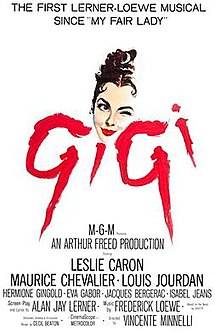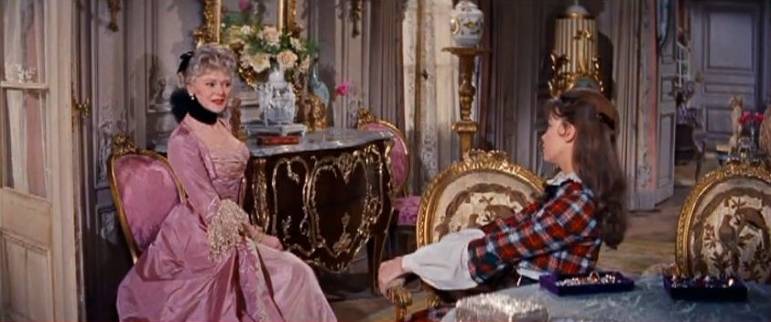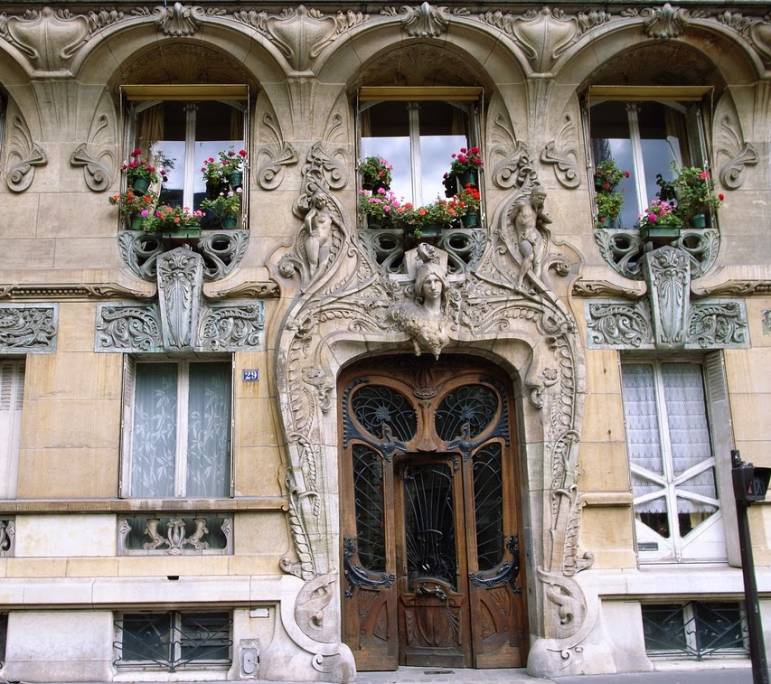
Let’s start the beginning of the year with the end — the end of what most fans would agree is the last of the great movie musicals. Selected by the Library of Congress as being “culturally, historically, or aesthetically significant,” based on of the book of the same name by famed French author Collette, (“Collette” the film was released this year. It can be viewed on Amazon) dominating the 1959 Oscars, winning every category of its nomination, totaling nine Oscars, the 1958 MGM film “Gigi,” denotes the end of an era.

Studio systems were facing a formidable opponent as television became the new American form of entertainment. This is not to say that musicals stopped being made. To the contrary, in the years to come what the average person considers a classic musical, i.e. “The Sound of Music,” were still produced, the difference being the type of musical. Splashy, candy-box films began to fall out of favor, in the late 1950s perhaps, in cryptic anticipation of the turbulent ’60s where a new generation was, understandably, unaccepting of escapist films.
With costumes, scenery and production design by the seminal Cecil Beaton and directed by the iconic Vincente Minnelli, set in the turn of the century during the time of La Belle Epoque, Gigi, (Leslie Caron) is a young girl on the brink of womanhood, in training to become a courtesan. The definition of a courtesan differs depending on who interprets it. In its softest interpretation is it is an elegant mistress of the highest quality. In its harshest light, it is defined as a most elegant prostitute … of the highest quality. Courtesans were trained in the art of femininity as well as the sensual arts and expected to be courted with jewels, as a form of securing a future in older years. Generally speaking, men who desired their company required a form of reference with no guarantee of acceptance of the female counterpart. Most courtesans were brilliant conversationalists or extraordinary entertainers. However, each had to be fascinating in her own right to compete.
Gaston (Louis Jourdan) plays a wealthy Parisian playboy becoming increasingly disappointed with his womanizing and superficial lifestyle. He has a longstanding friendship with Gigi’s grandmother and is a frequent visitor to Gigi’s home, where he finds grounded solace in its environment of much lesser means. As Gigi matures, Gaston becomes aware of her “spark that has turned to fire,” falling in love with her simple beauty and bold authenticity. However, although she is well aware of the reason for her training, she refuses his advances to become his mistress. Gaston must choose between his old life and true love.

According to IMBD, Louis Jourdan was born in Marseille, France. When his father was arrested by the Gestapo, Louis and his two brothers joined the French underground. His film career came to a halt when he refused to act in Nazi propaganda films. Most of his roles are relegated to the cultured dashing European lover, which he plays quite successfully in all of his films.
Leslie Caron was discovered while starring in the Ballets des Champs-Élysées by musical legend Gene Kelly, who brought her to MGM. She learned her part phonetically as she did not speak English. She went on to star in a series of musicals, one of her most popular noted as another Minelli masterpiece, “An American in Paris,” in 1951, in which she starred with Kelly. As of this release, she is living today at 87 years young.

Caron is in her mid-20s when she garners the role, playing a young woman suspected to be somewhere south of 15. She plays a carefree, headstrong and wise-beyond-her-years, character and this is revealed in one of the first scenes of the film. Surrounded by the famous “Minelli Red” setting of her home, when her grandmother, Madame Alvarez (Hermione Gingold) briefly reminisces about an opportunity lost on Gigi’s mother, of a wealthy suitor, Gigi, immediately questions her grandmother, in a pious tone, clearly letting it be known she is thoroughly aware of her environment and confident in her own suspicions.
An older dignified woman of the world, with a past full of rich male conquests, Aunt Alicia (Isabel Jeans) is Gigi’s mentor, training her in the artistry of the courtesan. Although attempts are made to dislike her character, some how, some way with no effort on her part, she wins you over, proving the efficacy of a true courtesan. Full of worldly wisdom, and in perfect cadence, she offers one of the most insightful lines in the film, in answering a serious query from the opinionated Gigi:
“Marriage is not forbidden to us, but, instead of getting married at once, it sometimes happens, we get married … at last.”

The debonair Maurice Chevalier plays the lovable rascal Honoré Lachaille, Gaston’s older uncle, obsessed with dating significantly younger women. In his second scene, when meeting with his nephew, he gives us a good indication of his comedic relief to come. He delivers laughable one-liners with perfect timing and speaks freely with no level of embarrassment regarding his philandering ways, often advising his young nephew in the art of womanizing. When Gaston discovers his current lover, Liane (Eva Gabor) is cheating, Honoré, Gaston and Honoré‘s butler commence a comical exchange where Honoré convinces his nephew to take hold of his male patriotism and confront his untrue lover in public.
According to IMDB, Chevalier had a background in entertainment, in his younger years, however, Chevalier was a POW captured by the Germans in WW l, where he learned English from fellow prisoners. When talkies came into being, he traveled to Hollywood and was paired with operatic singer/actress Jeanette MacDonald to make The Love Parade (1929). Although Chevalier was attracted to MacDonald and made several passes at her, she rejected him firmly, as she had designs on actor Gene Raymond, who she eventually married. He did not take rejection lightly, being a somewhat vain man who considered himself quite a catch and derided MacDonald as a “prude.” She, in turn, called him “the quickest derrière pincher in Hollywood.” Chevalier delivers one of his signature songs in this film, “Thank Heaven for Little Girls” which both opens and poetically closes the film.
Honoré and Madame Alvarez share a poignant song in this film. “I Remember it Well” is a conversation between ex-lovers of years past. The female, in graceful acceptance of the transition into her older years, the male in resistance attempting to continually grasp at his youth, whose memory is not as clear as it once was, evidencing his natural decline. Madame Alvarez softly reminds Honoré that he, too, is aging by cleverly reassuring him that he is still just as young as the time of their affair decades prior, not growing older, even though they both are fully aware he is.
He asks her mid-song, with a touch of sadness, “Am I getting old?”
She answers, looking into his eyes with a slight pitch of her head and a soft touch to his hand, “Oh no…not you.”
I always appreciated the simplicity, the delicacy of how Minnelli interpreted this interaction and symbolism as the changing colors of the sun setting behind them subtlety punctuate the subject of growing older. It’s a melancholy scene executed with understated grace and elegance. Chevalier also performs one more extremely notable song in this picture which rings with truth. “I’m So Glad That I’m Not Young Anymore,” is an amusing point of view from the wisdom of an older man, in review of his youth, comfortable in his been-there, done that attitude.
Cecil Beaton, who also was the costume designer for the award-winning “My Fair Lady,” is deserving (as is Vincente Minnelli) of an entire article alone. Art Nouveau was the newest form of design during the turn of the century and Vincente Minnelli being a French connoisseur was certain to include its sensual design in his film. From Aunt Alicia’s Art Nouveau magnificence setting of her home and the delicate touches to her extravagant costuming, Beaton matched her sumptuous surroundings of pageantry to her character with precise accuracy. He also mimics this in Lachaille’s bachelor pad as his surroundings are also a reflection of Art Nouveau, the most modern of the current day, once again emphasizing Lachaille’s blatant refusal of age.

Beaton’s costumes — each fabulously unique — is a humbling lesson in haute couture fashion. If there are any doubts to his genius, it does not take an eye of discernment to agree each gown is easily a character unto itself, verifying Beaton’s extraordinary capabilities and imaginative grasp as an aesthete. Liane’s flamboyant costume in the “She’s Not Thinking of Me” song once again mimics the character’s psyche as a free-spirited courtesan who is currently forsaking her lover.

“Gigi” differs from most musicals as one of the first movies to be filmed on location. Maxim’s (a real restaurant in France with a salacious reputation) was not a set. Most scenes of Maxims-de-Paris were filmed on location except for one, where the restaurant was rebuilt as a set on an MGM soundstage. Minnelli’s use of unison whispering at Maxim’s to ensure the cut-throat atmosphere of gossip is brilliant. The scenes in natural settings actually do take place on location in France. Minnelli films are and always have been movies that need to be viewed multiple times. His determination to stay true to all details of period pieces within his films is impeccable, and his purposeful placement of color garners his exquisite reputation. It’s no wonder why “Gigi” won each category it was nominated for, and the day after it swept the Oscars, MGM telephone operators were directed to answer all phone calls with “Hello, M-Gigi-M.”
Cecil Beaton and Vincente Minnelli create an unbeatable pairing in this picture. An exceptional film, with an exceptional cast, and per usual, exceptional MGM production values is the idyllic exit of the era for the Glorious Musical’s last curtain call.

Constance Cherise is a multi-passionate entrepreneur. She is a classic movie-lover, empowerment coach, foodie, Disco “everything” fanatic, aspiring writer and artist. You can contact her at constance.cherise@gmail.com.







